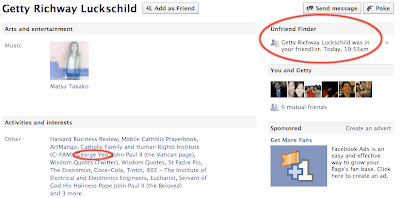
A status update I posted on Facebook: “Dear friends, I know many of us are disappointed that George Yeo has been voted out of Parliament. Remember that this is a corollary of the GRC system. If anything, don’t worry – we’re in safe hands; the WP will be campaigning for the abolition of the GRC system.”
Suddenly, I discover I’ve been un-Friended.

“Getty Richway Luckschild is no longer in your friend list.”
Confused. Why? I hop over to his profile to try and figure it out. Ah. So des ne.

